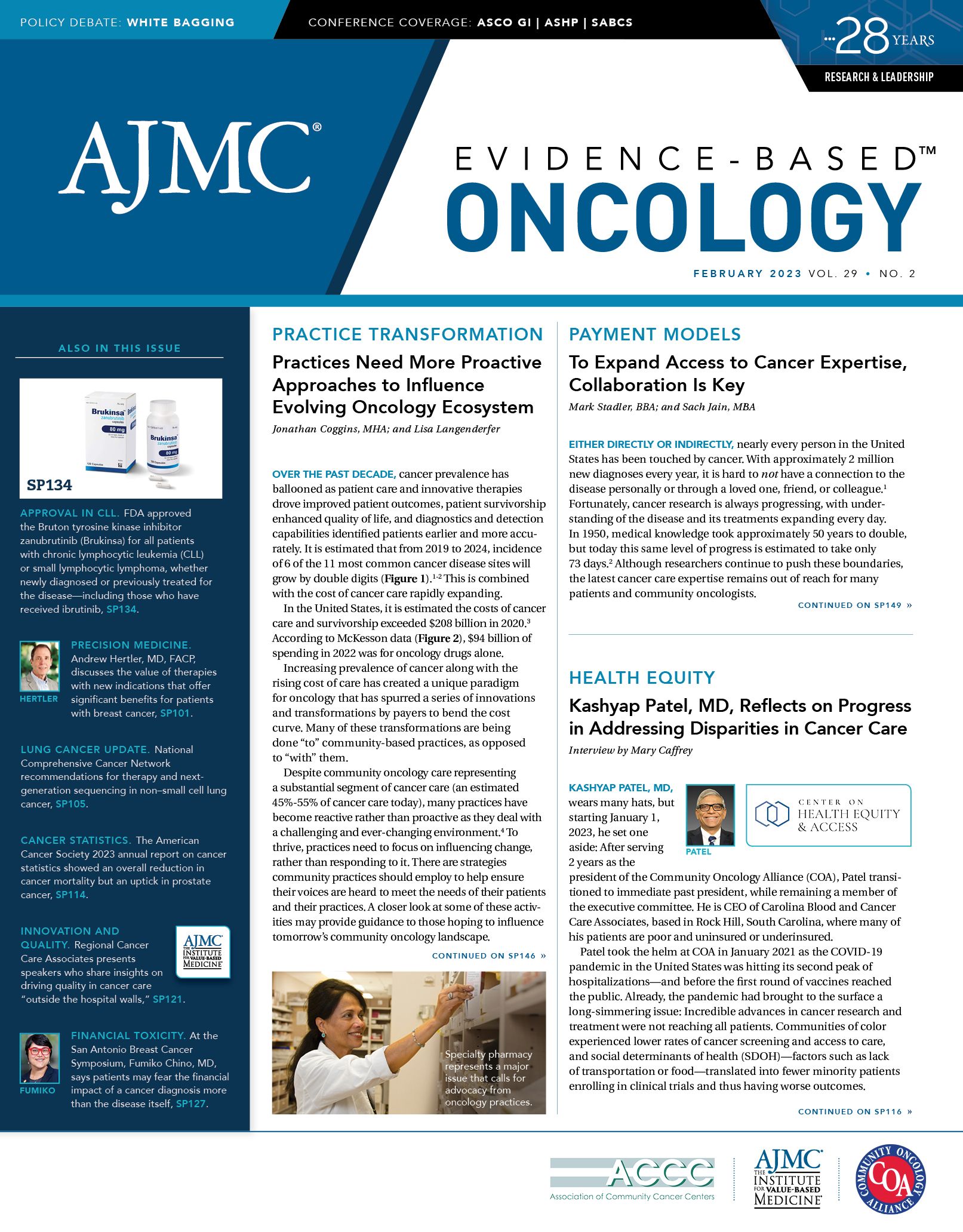- Center on Health Equity & Access
- Clinical
- Health Care Cost
- Health Care Delivery
- Insurance
- Policy
- Technology
- Value-Based Care
NCCN Guideline Update Reflects Rise of Precision Options in NSCLC
The latest updates in non–small cell lung cancer (NSCLC) cover recommendations for diagnostics, staging, when to use biomarker testing, sequencing of therapeutic options, and the addition of new treatments.
New findings from clinical trials, a new FDA approval, and increased use of biomarkers are reflected in the latest round of updates to the National Comprehensive Cancer Network (NCCN) Clinical Guidelines in Oncology for non–small cell lung cancer (NSCLC). The updates were published December 22, 2022, with a cover date of January 2023.1
NCCN clinical guidelines keep providers informed on ever-evolving clinical trial results and are considered the gold standard for guiding payer reimbursement decisions. NCCN guidelines also fuel clinical pathway frameworks such as Value Pathways by McKesson.2
The latest updates in NSCLC cover recommendations for diagnostics, staging, when to use biomarker testing, sequencing of therapeutic options, and the addition of new treatments. The prior updates were published in June 2022.
Therapeutic Options
Adjuvant therapy. The NCCN update features a detailed schedule for use of adjuvant therapy following surgery, refining when to use atezolizumab (Tecentriq; Genentech) or osimertinib (Tagrisso; AstraZeneca) for EGFR exon 19 deletion or exon 21 L858R.
Adagrasib. For NSCLC withKRAS G12C mutation, adagrasib (Krazati; Mirati Therapeutics), an inhibitor of RAS GTPase, has been added as a therapeutic option after first-line treatment. The therapy received FDA approval December 12, 2022, following presentation of trial data at the 2022 American Society of Clinical Oncology Annual Meeting and publication in the New England Journal of Medicine.3,4
The NCCN update notes that adagrasib and a previously approved therapy, sotorasib (Lumakras; Amgen), have a similar mechanism of action and, “it is not recommended to switch between these agents at the time of progression.”
Amivantamab. Amivantamab-vmjw (Rybrevant; Janssen) is a bispecific antibody directed at epidermal growth factor and MET receptors in patients with EGFR exon 20 insertion mutations. A new footnote in the NCCN update states that patients can receive amivantamab “if they have previously received mobocertinib and vice versa, because these agents have different mechanisms of action.” Mobocertinib (Exkivity, Takeda) is an irreversible kinase inhibitor.
Lorlatinib. In the section on NSCLC with ROS1 rearrangements, the NCCN update for patients who progress and have brain lesions adds lorlatinib (Lorbrena; Pfizer) as an option to entrectinib (Rozlytrek; Genentech) for those previously treated with crizotinib (Xalkori; Pfizer) or ceritinib (Zykadia; Novartis)
Evaluation, Testing, and Biomarkers
Pretreatment evaluation. Updated language on biomarkers and high-risk factors call for testing for PD-L1 status, EGFR mutations, and ALK rearrangements (stages IB-IIIA) on surgical tissue or biopsy. The NCCN update also outlines examples of high-risk factors, including “poorly differentiated tumors (including lung neuroendocrine tumors [excluding well-differentiated neuroendocrine tumors]), vascular invasion, wedge resection, tumors >4 cm, visceral pleural involvement, and unknown lymph node status.” The update continues, “These factors independently may not be an indication and may be considered when determining treatment with adjuvant chemotherapy.”
Genomic testing. Significant updates address ongoing challenges with access to next-generation sequencing (NGS). “Broad-based genomic testing approaches that efficiently utilize limited biopsy tissue while maximizing diagnostic genomic information are most commonly NGS-based. NCCN acknowledges that many currently available NGS-based assays used to fully genotype NSCLC are larger than the 50-gene limit threshold utilized by CPT coding convention; as a result, for panels larger than 50 genes, it may be practical to follow these recommendations. Either a single assay or a combination of a limited number of assays may be appropriate,” the update notes.
Additional language notes, “It is recommended at this time that, when feasible, testing be performed via a broad, panel-based approach, most typically performed by NGS. For patients who in broad panel testing don’t have identifiable driver oncogenes (especially in never-smokers), consider RNA-based NGS if not already performed to maximize detection of fusion events.”
Other testing-related updates address use of real-time polymerase chain reaction testing for specific mutations, and the addition of language regarding fluorescence in situ hybridization (FISH) analysis. The update notes, “FISH may have better sensitivity for gene amplification events in some circumstances.”
Blood testing. The update also states that testing using peripheral blood, or plasma-based testing of cell-free/circulating tumor [cf/ct] DNA, can be used in tandem with tissue-based testing to achieve genotyping for biomarkers. The update comments on the uses and limitations of cfDNA testing.
Biomarkers. In “Principles of Molecular and Biomarker Analysis,” the NSCLC guidelines have added a new section on ERBB2/HER2mutations.
References
1. NCCN Clinical Practice Guidelines in Oncology. Non-small cell lung cancer, version 1.2023. Accessed January 14, 2023. https://www.nccn.org/professionals/physician_gls/pdf/nscl.pd
2. Value Pathways powered by NCCN—Oncology Clinical Pathways. McKesson. Accessed January 3, 2023. https://www.mckesson.com/Specialty/Oncology-Pathways/
3. FDA grants accelerated approval to adagrasib for KRAS G12C-mutated NSCLC. News release. FDA. December 12, 2022. Accessed January 28, 2023. http://bit.ly/3WNMKi
4. Jänne PA, Riely GJ, Gadgeel SM, et al. Adagrasib in non-small cell lung cancer harboring a KRASG12C mutation. N Engl J Med. 2022;387(2):120-131. doi:10.1056/NEJMoa2204619

Insufficient Data, Disparities Plague Lung Cancer Risk Factor Documentation
September 24th 2023On this episode of Managed Care Cast, we speak with the senior author of a study published in the September 2023 issue of The American Journal of Managed Care® on the importance of adequate and effective lung cancer risk factor documentation to determine a patient's eligibility for screening.
Listen
